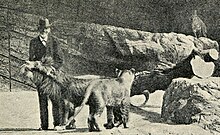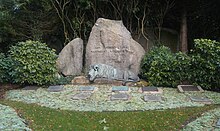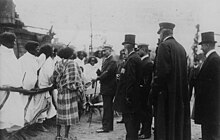Carl Hagenbeck
Carl Gottfried Wilhelm Heinrich Hagenbeck (born June 10, 1844 in Hamburg ; † April 14, 1913 there ) was a German animal trader, organizer of the Völkerschau and zoo director . He revolutionized and influenced zoo architecture worldwide by inventing naturalistic outdoor enclosures.
Life

His father, the fish merchant Gottfried Claes Carl Hagenbeck (1810–1887), started an animal trade in Hamburg in 1848 connected with animal shows, which Carl Hagenbeck took over in 1866 and expanded it to become the largest business of its kind in Germany. At first he sent four to five expeditions a year to Africa to catch animals, and later to the whole world. He also delivered all over the world, to the menageries of emperors and other rulers.
In 1875, Carl Hagenbeck's first Völkerschau opened based on an idea from animal painter friend Heinrich Leutemann (1824–1905). During the stay in Hagenbeck's exhibition grounds, visitors were able to watch the people of Lapland go about their everyday life. Hagenbeck's show celebrated great success. The little Lapland show moved from Hamburg to Berlin. Then she traveled to Leipzig. In order to remove the exhibitions from the environment of show booths and entertainment venues, attempts were made from now on to find reputable exhibition locations so that the shows were respected by the bourgeoisie. After the unexpected great success of Carl Hagenbeck's first Völkerschau, he quickly planned more. With the help of his connections to animal hunters all over the world, he brought three “ Nubians ” to Europe in 1876 and immediately afterwards an Eskimo family from Greenland. In 1883 and 1884 he organized a Kalmyks - and a Sinhalese - or Ceylon show. With the opening of his zoo in Stellingen in 1908 at the gates of Hamburg, Carl Hagenbeck had his own exhibition area, where Somalis , Ethiopians and Beduins performed. In the same year his Somali troop was exhibited in the Düsseldorf Zoo .
Hagenbeck opened a circus in 1887: Carl Hagenbeck's International Circus and Sinhalese Caravan, which later operated as Hagenbeck's Zoological Circus . In 1890 he introduced the tame training of wild animals and planned an open zoo without bars, for which he also acquired a patent in 1896. In the same year he performed with his animal circus at the Berlin trade fair , where he presented polar bears , seals and various birds in front of a 60-meter-deep and 25-meter-wide Arctic Ocean panorama. The circus became Circus Hagenbeck-Wallace in 1905 after it was bought up by an American circus . Carl's younger brother Wilhelm Hagenbeck (1850-1910) also ran a circus, which was later continued by Wilhelm's sons Willy (1884-1965) and Carl (1888-1949).
On May 7, 1907, in Stellingen , north of Hamburg , Hagenbeck opened the world's first gridless zoo on the basis of his patent , which still exists today as the Hagenbeck Zoo . This establishment was in competition with the zoological garden in Hamburg, which existed until 1930, and was boycotted by a majority of the German zoological gardens from 1909, from which competing animal dealers, such as the descendants of Ludwig Ruhe, profited. In 1911, Hagenbeck was portrayed by the painter Lovis Corinth together with the audience's darling at the time, the Walrus Pallas, commissioned by the Hamburger Kunsthalle , and the resulting painting Portrait of Carl Hagenbeck with the Walrus Pallas is still part of the Hamburger Kunsthalle's collection. In 1912 Hagenbeck was elected a member of the Leopoldina .
family
Carl Hagenbeck married Amanda, born on March 11, 1871 in Hamburg. Mehrmann (1849-1939). They had 10 children, five of whom reached adulthood - three girls and two boys. His brother Diederich (born 1852) died in 1873 of blackwater fever while fishing for hippos on Zanzibar. The two sons Heinrich (1875–1945) and Lorenz (1882–1956) were both owners of the Carl Hagenbeck company. Lorenz was also active in the pet trade and appeared at the exhibition in St. Louis, USA in 1904. He wrote the book Animals Are My Life .
Carl Hagenbeck was buried in Hamburg in the Ohlsdorf cemetery. On his grave, in front of a boulder with the engraved names Carl, Heinrich and Lorenz Hagenbeck, lay the bronze figure of the sleeping lion Trieste, Carl Hagenbeck's favorite animal. The lion had once saved his life when Hagenbeck stumbled in the outdoor enclosure and was attacked by a tiger. The sculpture was created by Josef Pallenberg , the artist who also designed the animal sculptures for the entrance to the zoo. The bronze lion was stolen at the beginning of January 2014.
On May 5, 1994, the Deutsche Bundespost issued a block of special stamps for his 150th birthday and the 150th anniversary of the Berlin Zoo.
criticism
Since interest in zoos slowly declined around 1870, Hagenbeck took up the idea of his painter friend Heinrich Leutemann and had animals from the far north accompanied by Sami . Since many onlookers came to see the "strangers", Hagenbeck produced 54 such exhibitions by 1913, in which large groups of people from traditional animal catching areas - mostly from Africa and Southeast Asia - were exhibited. The Völkerschauen were extremely successful commercially. Disproportionate to this were the low remuneration of the portrayed, who were often recruited with false promises. Black Africans, who were described as "semi-civilized" and exhibited in Völkerschauen, were treated much worse than Afro-Americans , who lived in imperial Germany, for example. B. performed as a musician. Medical care was also inadequate: an Inuit village community died of smallpox because they had forgotten to vaccinate them .
At the time of the Völkerschauen , many in Germany and Europe were of the opinion that one was entitled to exhibit “foreign” people in zoos, as Hagenbeck did on a large scale. The exhibitions were organized in such a way that they corresponded to and strengthened the stereotypical perception of the “peoples” exhibited by the white Europeans. The associated advertising media pursued the purpose of linguistically representing the “superiority” of Europeans over the cultures on display. The Völkerschauen were often given a scientific coating; as a result, Hagenbeck received honorary membership in an anthropological society.
The Völkerschauen appeared with the claim to "authentically" represent the life of the peoples depicted. During the visiting hours, the portrayed had to perform dances and rituals, which in the exhibition, however, were removed from their context in the cultures of the portrayed. In fact, the Völkerschauen conveyed an exotic image that had a decisive influence on the European perception of the foreign . Some critics of Hagenbeck and the Völkerschauen therefore take the view that the Völkerschauen had the purpose of winning the German population over to colonialism . The contents of the accompanying publication Carl Hagenbeck's illustrated animal and human world , published in hundreds of thousands of copies, were related to the colonial revisionism that was widespread in Germany after the loss of the colonies . Balthasar Staehelin, on the other hand, writes: "The colonial aspect of the Völkerschauen in the zoological gardens does not come to light in open propaganda for colonialism, but rather expresses itself in the formation of a mindset that connects zoos and non-European people in an associative and unreflected manner."
The critical whiteness research sees the Völkerschauen, which were organized by Hagenbeck and other entrepreneurs, as a particularly powerful example of racist practice in Germany during the imperial era.
Publications
- Articles about the life and goings-on of the Eskimos in Labrador and Greenland . From the diary of Mr. Carl Hagenbeck in Hamburg . Self-published by the editor, Berlin 1880.
- The importance of the zebus and zebu crossbreeds . Meissel, Hamburg 1890
- A review. Excerpt from the forthcoming, richly illustrated memoirs. Memories and experiences . Knackstedt & Näther, Hamburg 1907
- Of animals and people. Experiences and experiences. Vita German publishing house, Berlin-Ch. 1908. Digitized 81st to. 90th thousand. New cheap edition . 1909
- Hans Schomburgk : Wild and wild in the heart of Africa. Twelve years of hunting and research trips. Foreword by Carl Hagenbeck. Fleischel, Berlin 1910.
- Of animals and people. Experiences and experiences . With a foreword by Siegfried Seifert . New edition. List, Leipzig 1967
Radio plays
After 1945 two radio play productions were made about Carl Hagenbeck. The first radio play comes from NWDR Hamburg in 1952, the second from WDR and was created in 1962.
The NWDR production was written by Robert Walter and is entitled Get us 2000 dromedaries - a memory of the great animal master Carl Hagenbeck . The focus of the plot is an event from 1902. The Colonial Ministry in Berlin commissioned Hagenbeck to procure 2,000 dromedaries for the governor of Swakopmund ( German South West Africa ) . It is told how he succeeded in equipping a huge expedition, placing it under the command of his son Lorenz, who then managed to deliver the dromedaries of East African origin before the agreed date. Among others, Carl Voscherau (Hagenbeck), Erwin Wirschaz (his son Lorenz), Georg Pahl (Menges), Heinz Ladiges (speaker), as well as Willi Essmann , Eduard Marks , Heinz Roggenkamp and Reinhold Nietschmann spoke under the direction of Hans Freundt . The radio play is no longer available in any ARD broadcasting company.
Werner Liborius wrote the five-part children's radio play of the WDR under the title A Life with Animals: Carl Hagenbeck . Kurt Herrlinger composed the music . Under the direction of Wolfram Rosemann, the speakers included Friedrich W. Bauschulte (Hagenbeck as an adult), Raoul Wolfgang Schnell (Hamburger, narrator), Wolfgang Schirlitz (Leutemann), as well as Werner Kreindl , Heinz Bennent and P. Walter Jacob . The radio play is apparently still preserved.
literature
- Heinrich Leutemann : Biography of the animal dealer Carl Hagenbeck. Self-published by Carl Hagenbeck, Hamburg 1887. online e-book Uni Hamburg
- Alexander Sokolowsky : Carl Hagenbeck and his work . Haberland, Leipzig 1928
- Erna Mohr : Hagenbeck, Carl Gottfried Wilhelm Heinrich. In: New German Biography (NDB). Volume 7, Duncker & Humblot, Berlin 1966, ISBN 3-428-00188-5 , p. 487 f. ( Digitized version ).
- Hilke Thode-Arora : Around the world for fifty pfennigs. The Hagenbeckschen Völkerschauen . Campus Verlag, Frankfurt am Main [including] 1989 ISBN 3-593-34071-2 .
- Lothar Dittrich , Annelore Rieke-Müller : Carl Hagenbeck (1844–1913). Animal trade and exhibitions in the German Empire. Lang, Frankfurt [a. a.] 1998, ISBN 3-631-33474-5 .
- Ortwin Pelc : Hagenbeck at the world exhibitions in Chicago (1893) and St. Louis (1904) . In: Journal of the Association for Hamburg History . 86., Hamburg 2000, pp. 89-113.
- Klaus Gille : Hagenbeck, Carl Gottfried Wilhelm Heinrich. In: Franklin Kopitsch, Dirk Brietzke (Hrsg.): Hamburgische Biographie . Lexicon of persons. Christians Verlag, Hamburg 2003 ISBN 3767213664 , pp. 167-169.
- Haug von Kuenheim : Carl Hagenbeck. Ellert & Richter, Hamburg 2007, ISBN 978-3-8319-0182-1 .
- Eric Ames : Carl Hagenbeck's Empire of Entertainments. Washington 2008, ISBN 978-0-295-98833-7 .
- Pascal Blanchard , Nicolas Bancel , Gilles Boëtsch , Eric Deroo , Sandrine Lemaire (eds.): MenschenZoos. Showcase of inhumanity. Les Éditions du Crieur Public, Hamburg 2012, ISBN 978-3-9815062-0-4
- Klaus-Werner Haupt: Carl Hagenbeck and the whole world in one zoo . In: OKZIDENT & ORIENT. The fascination of the Orient in the long 19th century. Weimarer Verlagsgesellschaft / Imprint of the publishing house Römerweg Wiesbaden 2015, pp. 157–164 ISBN 978-3-7374-0220-0
Individual evidence
- ^ Johanna Lutteroth: 100 years of Carl Hagenbeck: The Lion King . In: one day . April 12th, 2013
- ^ Circus posters Willy Hagenbeck
- ^ Anne Dreesbach: Tamed savages. The display of “exotic” people in Germany 1870–1940. Campus-Verlag, Frankfurt / New York 2005, ISBN 3-593-37732-2 , p. 54.
- ↑ Gretzschel, Matthias, Pelc, Ortwin: Hagenbeck, Tiere, Menschen, Illusionen , Axel Springer Verlag, 1998, p. 177
- ^ English translation: Animals Are My Life. Translated by Alec Brown. Publisher The Bodley Head., London 1956.
- ↑ http://www.abendblatt.de/hamburg/article123648421/Diebe-stehlen-Loewen-vom-Grab-der-Hagenbecks.html
- ^ Nicole L. Butler: The Black Question (= Independent Study Project (ISP) Collection. Paper 365). Loyola University Chicago, Spring 2006, p. 10 ( PDF; 218 kB ).
- ↑ Regina Kusch: The King of Animals: 100th anniversary of the death of the zoo director Carl Hagenbeck . In: Deutschlandradio Kultur . April 14, 2013.
- ↑ Philipp Dorestal: Representations of the "exotic". "Tamed Wild" and "Völkerschauen" in Germany. In: analysis & criticism No. 504, March 17, 2006.
- ↑ Utz Anhalt: The People's Zoo. For the hundredth birthday of Hagenbeck's zoo ( memento from June 20, 2010 in the Internet Archive ). In: sopos. 7/2007.
- ^ Gisela Graichen , Horst founder : German colonies. Dream and trauma. Ullstein, Berlin 2007, ISBN 978-3-548-36940-2 , p. 394.
- ↑ Quoted from Anne Dreesbach: Tame Wilde. The display of “exotic” people in Germany 1870–1940. Campus-Verlag, Frankfurt / New York 2005, ISBN 3-593-37732-2 , p. 277.
- ^ Noah Sow : Germany black and white. Everyday racism. Bertelsmann, Munich 2008, ISBN 3-570-01008-2 .
Web links
- Literature by and about Carl Hagenbeck in the catalog of the German National Library
- Newspaper article about Carl Hagenbeck in the 20th century press kit of the ZBW - Leibniz Information Center for Economics .
- Of animals and people. Experiences and experiences at Zeno.org
| personal data | |
|---|---|
| SURNAME | Hagenbeck, Carl |
| ALTERNATIVE NAMES | Hagenbeck, Carl Gottfried Wilhelm Heinrich (full name) |
| BRIEF DESCRIPTION | German animal dealer and zoo director |
| DATE OF BIRTH | June 10, 1844 |
| PLACE OF BIRTH | Hamburg |
| DATE OF DEATH | April 14, 1913 |
| Place of death | Hamburg |






